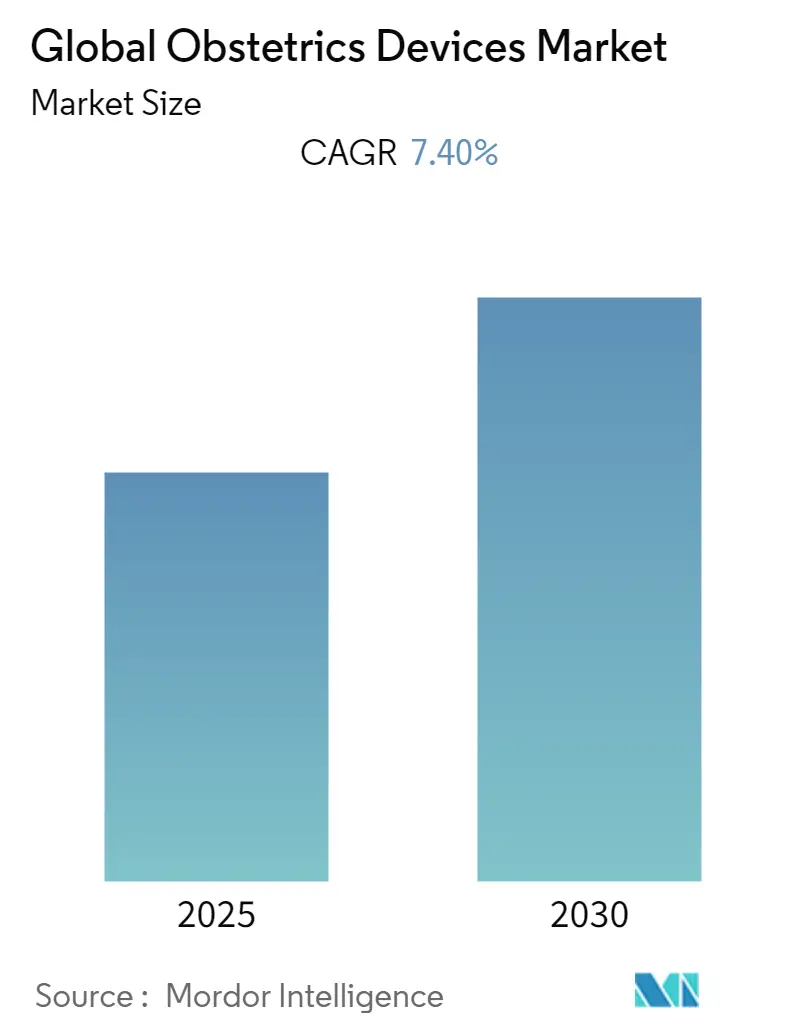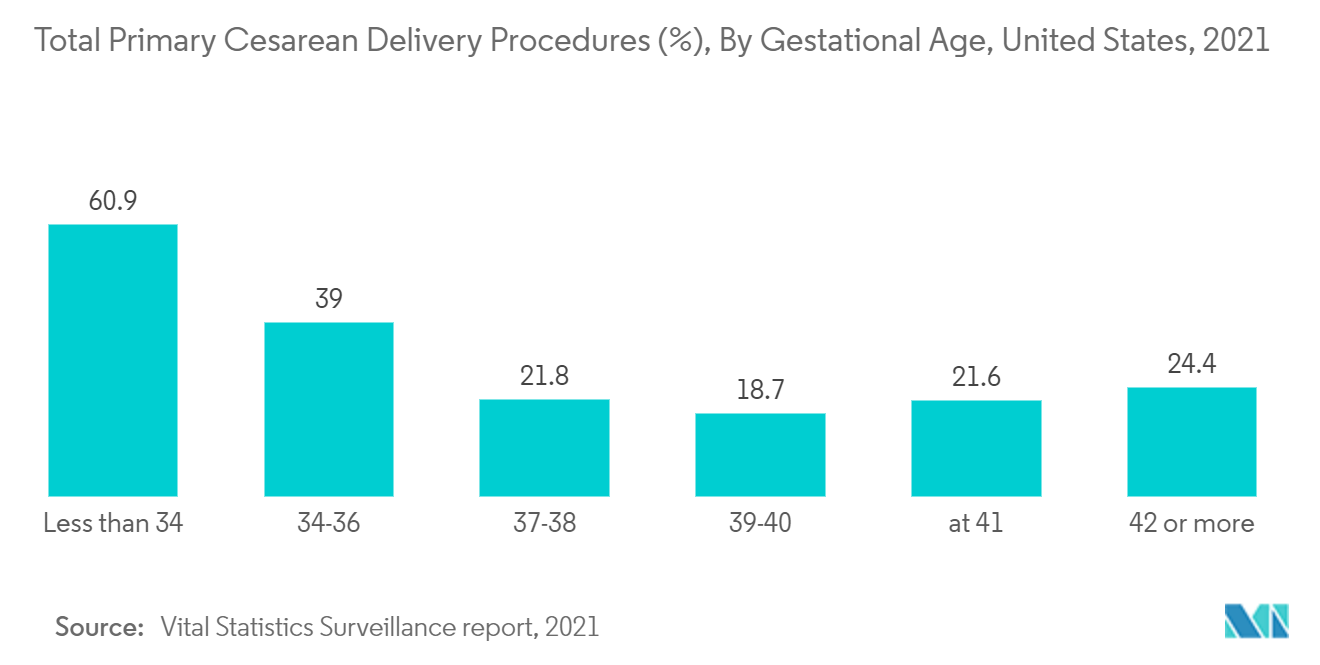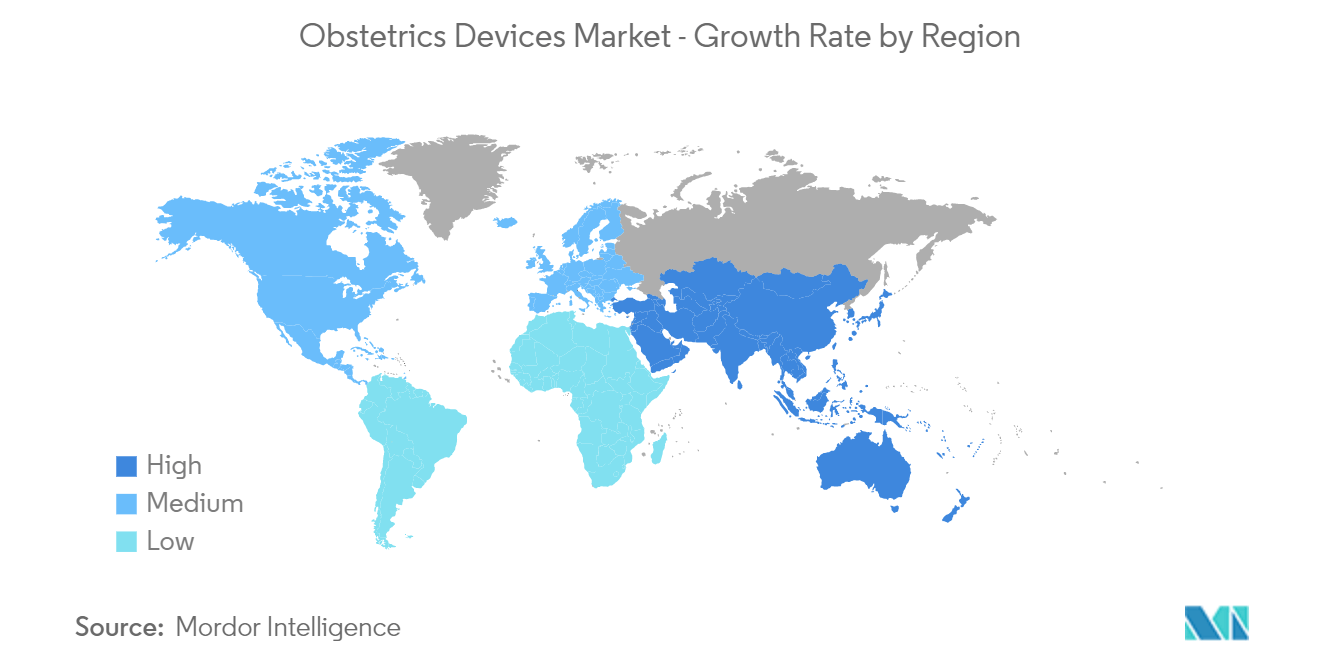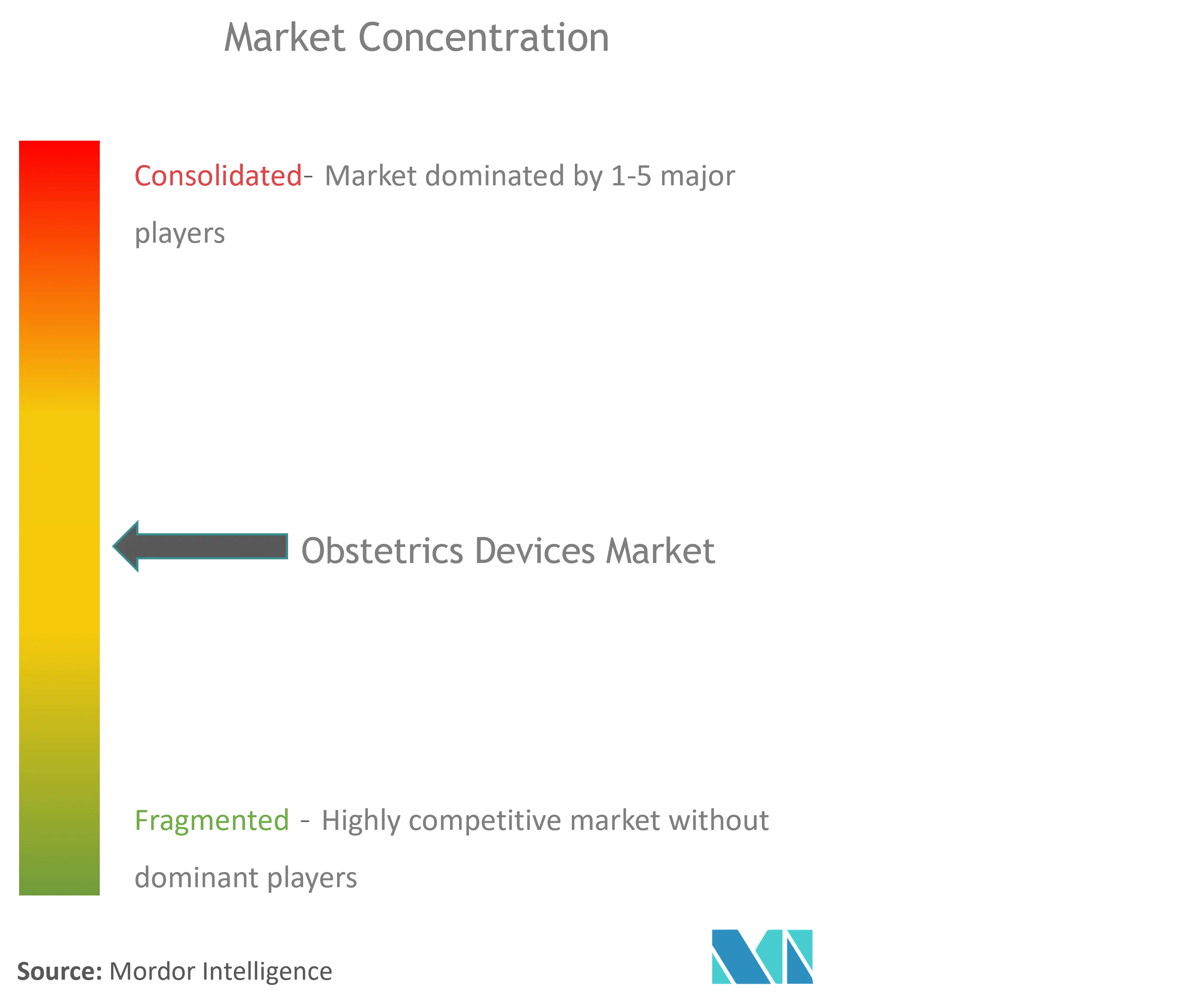
Obstetrics Devices Market Analysis
The Global Obstetrics Devices Market is expected to register a CAGR of 7.4% during the forecast period.
The COVID-19 pandemic has significantly impacted the preterm birth and PROM testing market. According to a study published in the International Journal of Gynecology and Obstetrics, in October 2020, titled "The effect of the COVID-19 pandemic on maternal health due to delay in seeking health care: Experience from a tertiary center," inadequate prenatal visits were observed in one-third of the women. Lockdown and fear of infection were the leading causes of delayed health-seeking, with 44.7% of pregnancies ending in complications. Also, according to a report published in the Gynecologic and Obstetric Investigation in July 2020, infection with COVID-19 during pregnancy raises the risk of pregnancy complications such as preterm birth, preterm premature rupture of the membranes, and, in rare circumstances, maternal mortality. Hence, COVID-19 has significantly impacted the market growth during the pandemic. However, with the releasing of COVID-19 restrictions and resuming services the studied market is expected to propel over the forecast period.
Certain factors that are propelling the market growth are the increasing birth rate globally and the rise in obstetric complications and assisted deliveries, as well as technological advancements in obstetrics. For instance, according to 2022 statistics published by the Centers for Disease Control and Prevention, the number of births and fertility rates have increased in the United States. As per the Births: Provisional Data for 2021 report, there was a 1% increase in births from 2020, with 3,659,289 births recorded in 2021. In addition, as per the same source, in 2021, the global fertility rate increased by 1% from the previous year to 56.6 births per 1,000 women aged 15 to 44.
Additionally, a rise in preterm birth, obesity, PCOS (Polycystic Ovarian Syndrome), and other gynecological conditions lead to increased obstetric complications and assisted deliveries. Increasing obesity results in the rise in labor complications and a growing number of C-section deliveries.
Furthermore, the incidences of premature birth and increasing death among children due to preterm birth are the key driving factors for the growth of the market over the forecast period. For instance, according to the data published by the Centers for Disease Control and Prevention, in 2021, the rate of preterm delivery among African American women was 14.9%, which is 50% higher than the rate among whites (9.1%) and Hispanic women (9.8%). Also, according to the statistics published by the March of Dimes, in 2021, it has been observed that the preterm birth rates rose from 14.25% to 14.36% among Black women and from 11.55% to 11.61% among American Indian/Alaska Native mothers. Similarly, as per 2021 data published by the Centers for Disease Control and Prevention, it has been observed that one in every ten infants born was premature, in the United States in 2020.
However, the risks associated with assisted deliveries are expected to restrain the market growth over the forecast period.
Obstetrics Devices Market Trends
Caesarean Delivery Segment Expects to Register a High CAGR in the Obstetrics Devices Market Over the Forecast Period
The Cesarian Section (C-Section) segment is expected to witness significant growth in the obstetrics devices market over the forecast period owing to the factors such as the rising number of cesarean deliveries and the rise in technological advancements.
The increasing cesarean deliveries is the key factor driving the segment's growth. For instance, according to 2022 statistics published by the Centers for Disease Control and Prevention, in 2021, the cesarean delivery rate rose to 32.1% and the low-risk cesarean delivery rate increased to 26.3%. This is expected to propel the segment growth over the forecast period.
Additionally, as per the data published by the World Health Organization, in June 2021, titled 'Caesarean section rates continue to rise, amid growing inequalities in access, the use of cesarean sections in deliveries is continuously rising globally, accounting for 21% of all childbirths and this number is projected to increase to 29% by 2030. Thus, the expected increase in the number of cesarean deliveries among the population is expected to fuel the demand for obstetrics devices that are required for performing a cesarean delivery, thereby propelling the segment's growth.
Thus, owing to the aforementioned factors, the market is expected to grow significantly during the forecast period.

North America Dominates the Market and Expects to do Same Over the Forecast Period
North America is expected to hold a significant share in the obstetrics devices market over the forecast period owing to the factors such as increasing birth rate, technological advancements in obstetrics, high healthcare expenditure in the region, and the presence of well-established healthcare infrastructure.
The rising number of cesarean deliveries in the region is also expected to fuel market growth. For instance, according to the data published by the National Vital Statistics Report, in July 2022, the overall cesarean delivery rate in the United States has increased from, 31.8% in 2020 to 32.1% in 2021. This is expected to increase the demand for obstetrics devices, thereby fuelling market growth. Additionally, as per the data published by the Centres for Disease Control and Prevention, in February 2022, it has been observed that in 2020, non-Hispanic Black women had the highest rate of cesarean deliveries (36.3%). Also, from the same source, the low-risk cesarean delivery rate increased from 25.6% in 2019 to 25.9% in 2020.
Additionally, according to the Organization for Economic Co-operation and Development (OECD), in June 2022, United States healthcare spending in 2021 was 17.8% of the total GDP of the country and Mexico's health spending as a share of GDP was 6.2% in 2020, This is expected to positively impact market growth. Additionally, as per the Centers for Medicare and Medicaid Services, National Health spending is projected to grow at an average annual rate of 5.4% for 2019-2028 and to reach USD 6.2 trillion by 2028. As national health expenditure is projected to grow 1.1% points faster than gross domestic product per year on average over 2019-2028 the health share of the economy is projected to rise by 19.7% in 2028. Thus, the increasing healthcare spending in the region is expected to increase the company's activities in developing technologically advanced obstetrics products, thereby propelling market growth.
Furthermore, the rising product launches in the region are also expected to boost market growth. For instance, in September 2021, Hologic, Inc. launched an expanded Omni suite, a comprehensive gynecological surgical offering designed to optimize diagnostic and operative hysteroscopy, in Europe, Africa, and the Middle East (EMEA). It includes a versatile Omni 30° hysteroscope, the Omni Lok cervical seal, and the Omni 5 French seal. Also, in November 2020, Hologic launched a comprehensive surgical offering, the Omni Suite, which can optimize diagnostic and operative hysteroscopy. The Omni Suite includes Omni 30° and 0° hysteroscopes, Omni 4K video system, and the Omni Lok cervical seal. The suite helps to customize operative capabilities and powerful visualization to diagnose and treat patients.
Thus, owing to the aforementioned factors, the market is expected to grow significantly during the forecast period.

Obstetrics Devices Industry Overview
The market for obstetrics devices is moderately competitive and consists of local as well as international players. However, the large share of the market is grabbed by international companies as they are having a worldwide presence with the United States FDA-approved devices. As the medical device industry is showing a boost, it is expected that there will be smaller to mid-sized companies penetrating the market studied and holding a substantial share in the market. Some of the key players in the market are Boston Scientific Corporation, Cooper Surgical, Hologic Inc., Medtronic PLC, Olympus Corporation, and Johnson & Johnson.
Obstetrics Devices Market Leaders
-
Boston Scientific Corporation
-
Cooper Surgical
-
Hologic Inc.
-
Olympus Corporation
-
Medtronic Plc
- *Disclaimer: Major Players sorted in no particular order
Obstetrics Devices Market News
- In June 2022, UroViu Corp launched a new Hystero-V, a single-use hysteroscope compatible with UroViu's Always Ready endoscopy platform.
- In January 2022, Inovus Medical launched a new high-fidelity hysteroscopy simulator, HystAR that combines the company's patented Augmented Reality technology and cloud-based learning platform with the natural haptics of its simulated tissue models to deliver highly realistic, scalable, tracked hysteroscopy skills training.
Obstetrics Devices Industry Segmentation
As per the scope of the report, obstetrics devices are associated with delivery/labor devices and differ according to the type of delivery. The Obstetrics Devices Market is segmented by Delivery Type (Normal and Cesarian Section (C-Section)), Product (Retractors, Delivery Forceps, Suction Pumps, and Others), and Geography (North America, Europe, Asia-Pacific, Middle East, and Africa, and South America). The market report also covers the estimated market sizes and trends for 17 different countries across major regions globally. The report offers the value (in USD million) for the above segments.
| By Delivery Type | Normal | ||
| Cesarian Section (C-Section) | |||
| By Product Type | Retractors | ||
| Delivery Forceps | |||
| Suction Pumps | |||
| Others | |||
| Geography | North America | United States | |
| Canada | |||
| Mexico | |||
| Europe | Germany | ||
| United Kingdom | |||
| France | |||
| Italy | |||
| Spain | |||
| Rest of Europe | |||
| Asia-Pacific | China | ||
| Japan | |||
| India | |||
| Australia | |||
| South Korea | |||
| Rest of Asia-Pacific | |||
| Middle-East and Africa | GCC | ||
| South Africa | |||
| Rest of Middle-East and Africa | |||
| South America | Brazil | ||
| Argentina | |||
| Rest of South America | |||
Obstetrics Devices Market Research FAQs
What is the current Global Obstetrics Devices Market size?
The Global Obstetrics Devices Market is projected to register a CAGR of 7.4% during the forecast period (2025-2030)
Who are the key players in Global Obstetrics Devices Market?
Boston Scientific Corporation, Cooper Surgical, Hologic Inc., Olympus Corporation and Medtronic Plc are the major companies operating in the Global Obstetrics Devices Market.
Which is the fastest growing region in Global Obstetrics Devices Market?
Asia Pacific is estimated to grow at the highest CAGR over the forecast period (2025-2030).
Which region has the biggest share in Global Obstetrics Devices Market?
In 2025, the North America accounts for the largest market share in Global Obstetrics Devices Market.
What years does this Global Obstetrics Devices Market cover?
The report covers the Global Obstetrics Devices Market historical market size for years: 2019, 2020, 2021, 2022, 2023 and 2024. The report also forecasts the Global Obstetrics Devices Market size for years: 2025, 2026, 2027, 2028, 2029 and 2030.
Our Best Selling Reports
Global Obstetrics Devices Industry Report
Statistics for the 2025 Global Obstetrics Devices market share, size and revenue growth rate, created by Mordor Intelligence™ Industry Reports. Global Obstetrics Devices analysis includes a market forecast outlook for 2025 to 2030 and historical overview. Get a sample of this industry analysis as a free report PDF download.




